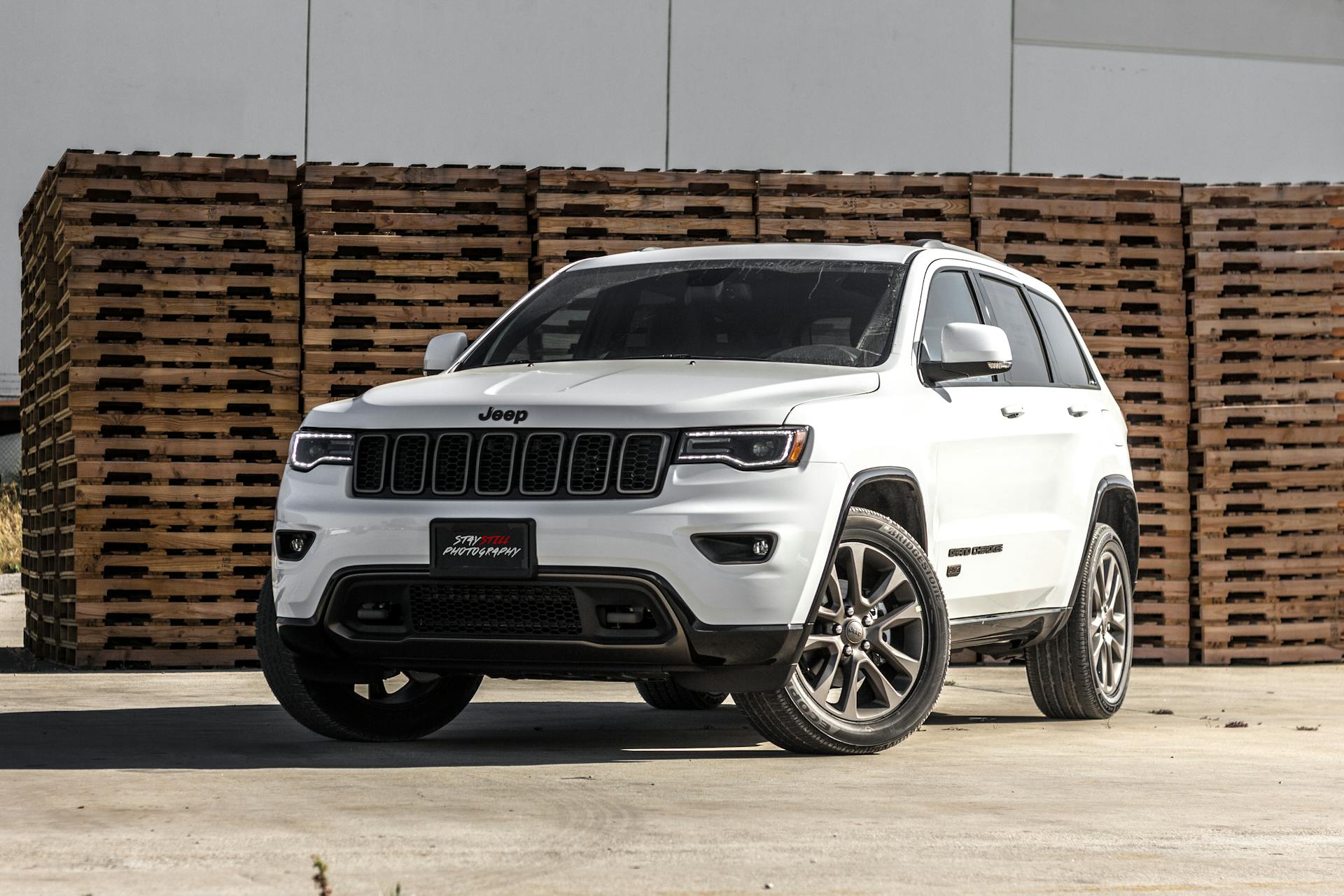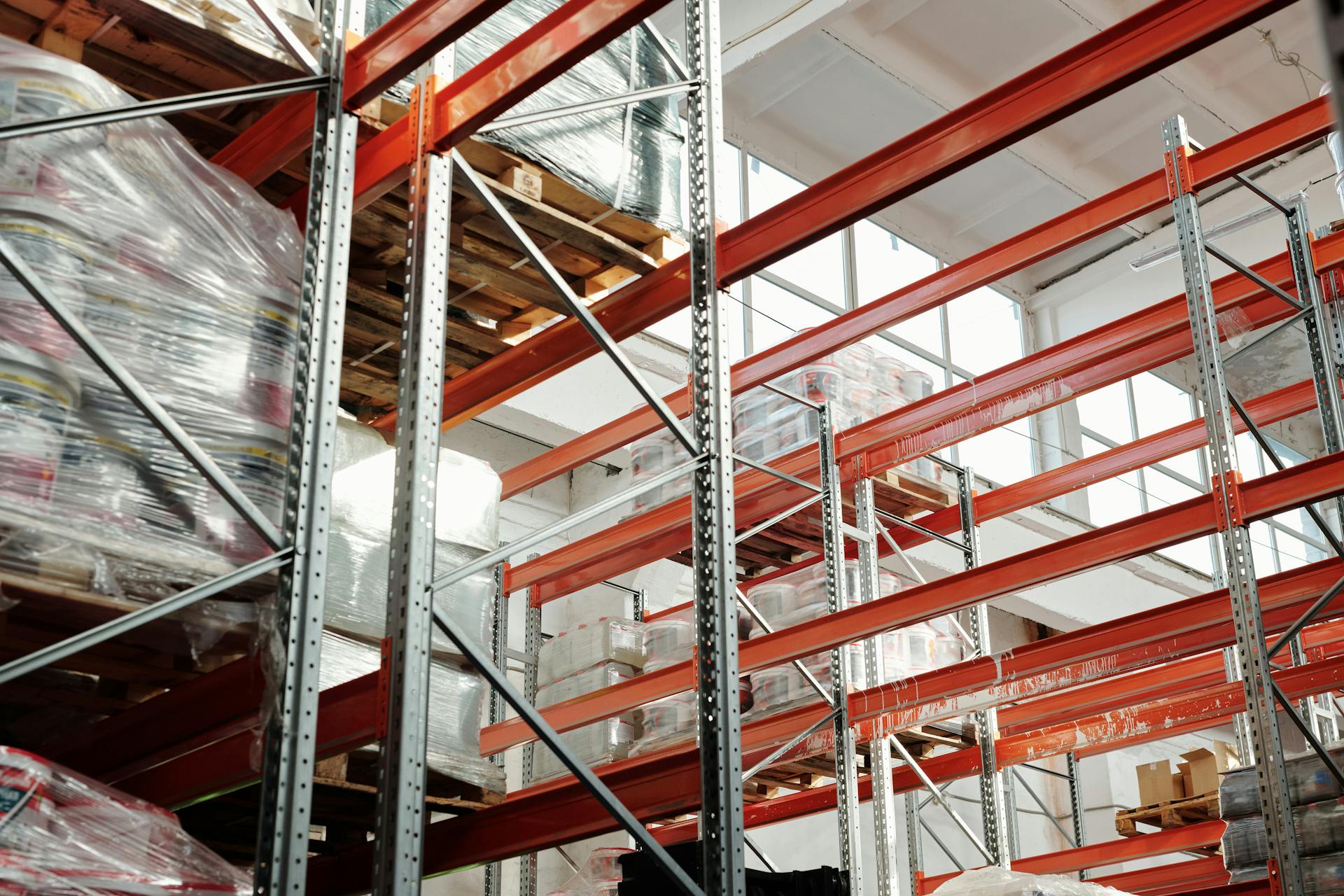
Pallets come in various lengths, but most standard pallets are around 40 inches long. This length is widely used in the United States and Canada.
In Europe, pallets are typically 800mm to 1200mm long, with 1200mm being the most common length. This is often referred to as an EPAL (European Pallet Association) pallet.
The length of pallets can vary depending on the region and industry, but 40 inches and 1200mm are the most widely used lengths.
Consider reading: Long Fork Pallet Truck
Pallet Dimensions
The most common pallet size in North America is 48 inches wide by 40 inches long, used by many industries including retail, grocery, and manufacturing.
In North America, other popular sizes include the 42 inches by 42 inches and the 48 inches by 48 inches pallets, which fit perfectly in trucks and shipping containers. The 40 inches by 48 inches pallet is also used in the military and cement industries.
The International Organization for Standardization (ISO) sanctions six pallet measurements, detailed in ISO Standard 6780. The six ISO pallet sizes are: 48 x 40, 42 x 42, 39.37 x 47.24, 43.30 x 43.30, 31.50 x 47.24, and 44.88 x 44.88.
Here are the six ISO pallet sizes:
North America Dimensions
In North America, the most commonly used pallet size is the 48in x 40in pallet. This size is used by most industries, including retail, grocery, and manufacturing.
Other popular sizes include the 42in x 42in and the 48in x 48in pallets, which are designed to fit perfectly in North American trucks and shipping containers. These pallets are widely used in various industries.
Here are some common North American pallet dimensions:
These pallet dimensions are widely used in North America and can be found in various industries.
CP
CP pallets are a type of pallet widely used in the chemical and construction industries. They're developed in cooperation with the Chemical Industry Association and are known for their uniformity and strong closely spaced boards.
One of the key features of CP pallets is their winged edges, which help protect the blocks and the integrity of the pallet in case of spills. This design also makes it easier to shrink-wrap pallet loads, a common method in the Chemical industry.
Curious to learn more? Check out: Which End of Pallet Industry Standard for Lifting Pallets Forklifts
There are 9 CP pallet sizes available, each with its own unique dimensions. Here are the different sizes:
- CP1: 1200x1000mm Winged pallet
- CP2: 1200x800mm Winged, Three Legger pallet
- CP3: 1140x1140mm square Winged, Three Legger pallet
- CP4: 1300x1100mm Winged, Three Legger pallet
- CP5: 1140x760mm Winged, Three Legger pallet
- CP6: 1200x1000mm Winged pallet with a perimeter base
- CP7: 1300x1100mm Winged pallet with a perimeter base
- CP8: 1140×1140mm pallet with a hole in the middle
- CP9: 1140x1140mm Winged pallet with a perimeter base
Pallet Types
There are several types of pallets, each with its own unique characteristics.
Standard pallets are the most common type, measuring 40 inches wide by 48 inches long.
They're typically made of wood and are used for shipping a wide range of products.
Block pallets, on the other hand, are a bit larger, measuring 48 inches wide by 40 inches long.
This reversed size makes them ideal for shipping heavy or oversized items.
Stillage pallets are designed for shipping large or irregularly-shaped items, often featuring a flat top and reinforced corners.
These pallets can be custom-made to fit specific products, making them a popular choice for manufacturers.
Chep pallets are a type of plastic pallet, known for their durability and resistance to moisture.
They're often used in the food and beverage industry, where sanitation is a top priority.
See what others are reading: Cool Things Made from Pallets
European Dimensions
European pallets come in various dimensions, but the most common size is 1200mm x 800mm (47.24in x 31.50in).
This size, known as EUR or EUR 1, is widely used in Europe, Asia, and Africa. It's designed to fit perfectly in European trucks and shipping containers.
Other popular sizes include the 1200mm x 1000mm (47.24in x 39.37in) and the 800mm x 600mm (31.50in x 23.62in) pallets. These sizes are also used in various parts of the world.
Here are some common European pallet dimensions:
The Plastic
The Plastic Pallet is a great option for many businesses. It's made from recycled and recyclable plastic, and can have a long useful life of over 10 years.
One of the benefits of plastic pallets is that they are 100% recyclable and can be ground up and turned back into a new pallet. This makes them a very sustainable option.
Plastic pallets are also safe to handle, with no screws, nails, splinters or chipping. This makes them ideal for handling food, paper, pharmaceuticals, and other sensitive products.
They're also resistant to acids, alkalis, fats, solvents, and odors, and are waterproof, resistant to bacterial contamination, and don't absorb humidity.
Here are some key features of plastic pallets:
- Long useful life of over 10 years
- 100% recyclable
- Natural ISPM 15 compliance
- EURO pallet dimensions available
- High loading capacity and anti-slip surface
- Lightweight (from 5.5 kg for a standard 1200×800 mm)
Plastic pallets are also very durable, and can withstand stress and shock. They're easy to stack, handle, and clean, making them a great option for many businesses.
Custom Wooden
Custom wooden pallets are a great option for businesses that need to transport large or oddly shaped products. They can be designed to meet specific needs, ensuring products arrive safely and securely.
The most common custom wooden pallet sizes include 36″ x 36″, 40″ x 40″, 48″ x 36″, and 48″ x 48″. Some custom pallets can even be up to 48 feet in length and 100 inches in width.
Custom pallets can hold up to 4,600 lbs, making them suitable for heavy loads. The type of wood used is also important, as different types have varying weight capacities and durability levels.
Some common types of wood used for custom pallets include those used in the standard pallet sizes mentioned earlier. Custom pallets can also be designed with specific features, such as heat treatment and bark-free options, for export needs.
Here are some common custom wooden pallet sizes:
What is a Pallet?
Pallets come in all shapes and sizes, and they're not just made of wood anymore. Most pallets manufactured in the world are made of wood, but you can also find pallets made of other materials.
You can find pallets made of plastic, metal, paper/cardboard, and even recycled materials. These alternative materials are becoming increasingly popular due to their durability and eco-friendliness.
Here are some common types of pallets:
- Plastic pallets
- Metal pallets
- Paper/cardboard pallets
- Recycled material pallets
Pallet History and Information
In the past, pallet sizes varied greatly between industries, with each making their own pallets for their specific needs.
This lack of standardization made trade between different regions and countries quite challenging.
The European market, for example, made small pallets that were 800mm wide, which was perfect for transporting goods by train and easily fitting through doorways.
The UK and North America, on the other hand, had trade routes that mostly involved shipping by boat, so their pallets were sized to fit into shipping containers with minimal wasted space.
Having more standard pallet sizes across the world has been a game-changer for trade industries.
Related reading: Shipping Mark Pallet
The History of
The History of Pallet Sizes is a fascinating story that shows how industry standards can make a big difference in trade.
In the past, each industry made pallets for their own purposes, without considering the size of other industries' pallets.
The European market used to make small pallets that fit into trains and doorways, with most doorways measuring 850mm wide, but the pallets were only 800mm wide.
Trade between the UK and North America was mostly by boat, so their pallets were sized to fit into shipping containers with minimal wasted space.
Having more standard pallet sizes across the world has been massively beneficial for trade industries, making it easier to transport goods.
Region-specific and country-specific sizes are becoming less popular, and it's expected that the less commonly used sizes will eventually die out.
For your interest: Industry Pallets
Factors Influencing

Factors Influencing Pallet Size are determined by the weight it can hold, storage, and transportation needs.
The size of a pallet can vary significantly, with some pallets measuring 40 inches by 48 inches and others as small as 24 inches by 36 inches.
Pallet size is influenced by the type of goods being transported, with larger pallets often used for heavy machinery and smaller pallets used for smaller items.
The size of a pallet also affects how it can be stored, with larger pallets taking up more space in warehouses and storage facilities.
For more insights, see: How Large Are Pallets
Pallet Regions
Pallets come in various sizes depending on the region. In North America, the most commonly used pallet size is 48 x 40 inches (1219 x 1016mm), suitable for grocery and other uses.
The International Organization for Standardization (ISO) has approved six global pallet sizes, which are widely used around the world. These include 48×40 inches (1219x1016mm) for North America, 1200x1000mm for Europe and Asia, and 45.9×45.9 inches (1165x1165mm) for Australia.

Here are the six ISO-approved global pallet sizes, listed in a table for easy reference:
Global
The world of pallets is a vast and varied one, and it's essential to understand the different regions and their specific pallet sizes. In Australia, the most commonly used pallet size is 1165mm x 1165mm (45.87in x 45.87in).
The International Organization for Standardization (ISO) has approved six global pallet sizes, which are widely used across the world. These sizes are 48×40 inches (1219x1016mm), 1200x1000mm, 45.9×45.9 inches (1165x1165mm), 42×42 inches (1067x1067mm), 1100x1100mm, and 1200x800mm.
In North America, the standard size wooden pallet is 48” x 40.” This size is recognized by the ISO as one of its six standard sizes.
The ISO-approved global pallet sizes are beneficial for companies that ship their products worldwide, as they can prevent the need to switch pallets to local sizes at the other end of their journey.
Here's a summary of the 6 most common ISO-approved global pallet sizes:
Go International
The need for standard-sized pallets wasn't unique to the United States. Several nations began creating organizations to deal with standardization challenges in the early 20th century.
After World War II, many of these organizations came together to facilitate trade and established the International Organization for Standardization (ISO). ISO creates global standards for dimensions and measurements, which applies to manufacturing, transportation, and warehousing.
The 48×40 standard pallet size is one of six different ISO standard pallet dimensions for wooden pallets. You'll find all those dimensions below.
ISO only governs the sizes of pallets, not the wood materials themselves. The International Plant Protection Convention (IPPC) regulates the wood materials to ensure they meet International Standards of Phytosanitary Measures (ISPMs).
ISPM 15 affects all wood packaging, including pallets, crates, and dunnage, and sets the standard for wooden pallets to stop the spread of invasive species of bugs and mold around the world.
Expand your knowledge: Block Pallet Dimensions
Other
Pallet regions can be quite diverse, but there are some commonalities that set them apart.

In the Eastern United States, for example, the Appalachian region is home to many small-scale pallet manufacturers.
Pallets in this region tend to be made from hardwoods like oak and maple, which are abundant in the area.
The Great Lakes region, on the other hand, has a more industrialized pallet market, with many large manufacturers producing pallets made from softwoods like pine and spruce.
This region's proximity to major shipping routes makes it an ideal location for pallet production and distribution.
In the Western United States, the Pacific Coast region is known for its high-end pallets, often made from exotic hardwoods like teak and eucalyptus.
These pallets are highly prized for their durability and aesthetic appeal, making them a popular choice for high-end applications.
Sources
- https://www.connerindustries.com/what-is-the-standard-pallet-size/
- https://www.universalpallets.com/2018/03/ultimate-guide-pallet-sizes-2/
- http://imarkmosaic.com/blog/standard-pallet-sizes-dimensions/
- https://crateandpack.com/what-are-standard-pallet-sizes-and-why-does-it-matter/
- https://www.woodenbowties.com/how-big-is-a-wooden-pallet/
Featured Images: pexels.com


